Individual digital image of a person as a factor of capitalisation of personality
Individual digital image of a person as a factor of capitalisation of personality
Abstract
A person, as an individual entity, is the most significant component of a social ecosystem, comprised of communities, and is himself a biological ecosystem governed by the overarching laws of nature. Formulating its mathematical model and evaluating its "capitalization" within the ecosystem presents a complex task for biology and mathematics. A mathematical model of humanity encompasses both biological and social attributes. For instance, factors determining one's knowledge and skills, which are demonstrated and honed through continuous education, along with other influences on performance related to health. This paper focuses on the research outcomes and methodological developments, as well as software and technological solutions, for the creation and utilization of a dynamic Personal Digital Image (PDI) throughout the lifespan. The scope of application lies in the economic and managerial domains of production and educational communities, founded on the regular monitoring of intellectual and psychophysical indicators.
1. Introduction
Assessing individual capabilities and knowledge is a pertinent scientific and practical challenge. The concept of intellectual capital was initially broached six decades ago in the works of J. Galbraith. Back then, companies showed little concern for the presence or condition of their intellectual assets, but by the 1980s, the landscape began shifting due to external pressures, prompting them to seek new competitive edges. Intellectual capital emerged as a strategic resource, enabling firms to establish enduring value (Kristandl, 2007). By the 2010s, the issue was clearly defined, and methodologies for addressing it began to surface (Mondal, 2012; Dumay, 2013). Intellectual property, in its typical form, encompasses patents, licenses, copyrights, etc. Infrastructural assets encompass those elements facilitating organizational processes, employee communication, and departmental operations, including corporate culture and databases. It's crucial to devise methods for evaluating human capital dynamically rather than solely relying on formal attributes, given that learning and development persist throughout an individual's entire lifespan in the contemporary world.
The modern theory of human capital possesses a robust toolkit for assessing its development across all stages of reproduction. The systematization presented in enables the identification of several key approaches to measuring human capital, including:
1) measurement using natural indicators (representative estimates);
2) measurement based on past efforts' evaluation;
3) measurement of the stock of human capital based on returns assessment.
Of particular interest is the World Bank's approach, which revolves around evaluating individuals' capacity to engage in the production process, encompassing their knowledge, experience, and labor skills. Investments in human capital are viewed as expenditures on healthcare, education, technical training, and other activities aimed at enhancing people's productivity.
According to D. Jorgenson and B. Fraumeni's approach , the accumulation of human capital can enhance individuals' productivity in both non-market and market activities. Consequently, it is inferred that investment in education fosters the formation of human capital, likening it to physical capital. Moreover, it is crucial to consider that investments in human capital should yield a sufficiently high level of return and profitability. These investments encompass not only educational costs but also foregone earnings. Evaluating the economic efficiency of education involves comparing its benefits and costs, accounting for the time factor.
2. Research methods and principles
This paper presents our solution for the assessment of human capital, which elaborates and specifies the system for continuously evaluating a person's intellectual and related qualities, allowing for the dynamic nature of indicators characterizing these qualities. The solution is grounded in a methodology for assessing a person's Personal Digital Image (PDI), which holds paramount importance for the economy of any ecosystem, primarily influencing the capitalization of social and productive groups. Its formation covers the entire lifespan of a human, commencing in early childhood through preschool and primary education, and extending into secondary, tertiary, and vocational education. Throughout this ongoing process, individuals engage in social groups with internal interaction rules, expressing their personal qualities and abilities, which shape their standing within these social groups over their lifetime. Notably, professional skills, knowledge, and the ability to effectively perform various roles (such as performer, task setter, manager, etc.) are crucial. Therefore, PDI serves as a tool for gauging a person's "value" across different life scenarios, acting as a "compass" for both self-development and for those seeking their professional services. In a broader sense, PDI can be viewed as an assessment of a person's "value" in the eyes of various target communities encountered throughout life while selecting different paths of social engagement.
3. Discussion
Utilizing the PDI of community members allows for adjustments to the community's capitalization indicator, aligning it more closely with market indicators, which are currently underrepresented in practice. In addition to the conventional measure derived from economic factors, we incorporate an intellectual component, defined as a function of the PDI of community members (for instance, a weighted average of:
where and
represents a weighting factor determined by the extent of rights granted by the i-th member to utilize their intellectual asset - PDI).
This modification facilitates the consideration of the quality of human capital among participants and the potential to manage their training and utilization in professional activities. Increasing participants' PDI scores represents a process of internal value generation, which warrants consideration when assessing community capitalization.
Another new parameter we consider in the modified capitalization indicator is the intensity of the community's external and internal communication processes. A higher indicator suggests a greater likelihood of transactions that boost revenues occurring more frequently. However, excessively high intensity could indicate chaotic actions stemming from low levels of management and organization. Hence, this indicator is merely supplementary and should be utilized considering its correlation with other indicators.
Assessing communication intensity necessitates specialized algorithms. Basic considerations when factoring in correlation dependencies include the volume of internal and external commercial transactions among community members (such as asset and product purchases and sales), the volume of internal value generation — among which is the PDI of community members and certain other parameters.
Furthermore, the proposed approach modifies the concept of internal assets and the capitalization of communities of varying types. Corresponding "intellectual indicators" can be evaluated in conventional units, akin to the community's internal currency, and added to standard estimates of community "capitalization" derived from economic indicators. Consequently, the assessment of a business company's capitalization incorporates indicators from its operational success, financial and other assets, alongside intellectual indicators, resulting in a more accurate valuation of the company's shares.
Capitalization in universal monetary units stands as a key characteristic, subject to transaction success, supply and demand fluctuations, and exchange rates. Within a community, capitalization automatically diminishes if a participant refrains from transactions (as the assessment factors in information exchange intensity). The community itself possesses its capitalization, encompassing rights to community capital for its stakeholders and working capital owned by both the community and its members.
Numerical assessments of interaction can be facilitated through financial and monetary relationships influencing the community's overall value. The generation of "intellectual currency" through participant development and support is crucial. The objective of this paper is to analyze various approaches to implementing this function, considering the nuances of current social relations and digital "intelligent information technologies".
The proposed modification of capitalization valuation algorithms, incorporating the intellectual component and communication intensity into standard economic valuations, facilitates the digitalization of informal and challenging-to-account-for "intellectual assets" formed and altered in learning and production processes. This approach enables a more reliable assessment of individuals and communities based on their PDI and potential market value.
Thus, this approach accounts for the 'intellectual value component' included in the capitalization of communities, wherein specialists of various professions, who significantly impact economic outcomes, constitute important members. This formalizes an intuitive evaluation of community capitalization, where the "quality and quantity of participants" and connection intensity determine their market position. Particularly crucial is this approach for evaluating communities dedicated to training and promoting personnel in the labor market professionally.
The primary effect of implementing these solutions lies in enhancing the efficiency of acknowledging and utilizing individual abilities and skills of market participants in social and professional environments.
To implement the proposed approach effectively, the most crucial task is to develop a technology for creating dynamic Personal Development Index (PDI) for each participant in the labor and education markets. Our solutions, tested practically in the educational processes of ITMO University and with private teachers working with school students, have been instrumental in this regard. By leveraging objectively obtained assessments, we significantly enhance existing methods for evaluating intellectual indicators and qualities, thereby expanding their applicability in addressing personnel and educational challenges.
Consequently, we gain the capability to factor in not only financial outcomes and assets but also "the quality of teamwork and management" when assessing the value of each social or industrial community. This data serves as the foundation for managerial decisions in production processes and business project transactions.
In essence, the intangible assets of ability, knowledge, and health can substantially augment the reliability of community valuations and overall capitalization. This naturally accounts for synergies resulting from the aggregation of more capable and competent individuals within the same community. As a result, a community's market capitalization can far exceed the sum of its individual participants' capitalization if their personal qualities are well-aligned with the community's objectives, and effective communication prevails among them.
The generation of value based on PDI within communities is pivotal for productive activity. Communities cannot sustain indefinitely without continuously generating new value. Even minor energy and information flows can mitigate vulnerability to external influences, preventing a significant increase in entropy and ensuring sustainability. Currency transactions mirror information and energy flows, and delays in external inputs can precipitate a sharp rise in entropy (disorder) and compromise sustainability, leading to typical crisis scenarios.
The development and utilization of each individual's abilities within digital communities enhance the efficiency of material production and engender new intangible assets, thereby amplifying the value of intellectual assets and information exchange. In our approach, we envisage communities where new assets are generated by enhancing the capitalization of participants and connections. We evaluate the resultant impact through regular monitoring of comprehensive indicators. Our algorithm hinges on comparing the forecasted score of integral indicators derived from current values with the actual values obtained during subsequent measurements. Discrepancies between forecasts and actual results signify either an increase or decrease in system entropy. Failure to reduce entropy jeopardizes system stability. This outcome informs control decisions that influence the pertinent elements within the community structure or externally introduced components.
The model of capitalization of abilities, knowledge, and skills acquired through learning, along with health indicators from health monitoring, underpins our framework effectively . A financial and technological digital platform has been developed to support registration and accounting transactions. This technology-enabled platform serves individual communities and forms the basis for the digital ecosystem to which those communities are connected. The communities linked through this underlying digital platform constitute an ecosystem. The platform caters to various types of communities and facilitates the establishment of mechanisms for their internal and shared capitalization, supports the infrastructure of information exchange between participants and partner communities (both external and internal), and organizes joint motivational schemes, among other functions. The internal currency of each community is implemented using blockchain technology, specifically designed to serve relatively small communities (with several million participants or more).
Each entity (not only individuals but also organizations) possesses a "digital image," comprising parameters determining its current evaluation relative to other entities. To thrive and sustain active engagement in modern society, it's essential to regularly obtain and update one's "digital image." In our approach, any ecosystem comprises subsystems united by information exchange. Thus, the Personal Development Index (PDI) of an entity is a function of a set of time-dependent indicators and is described by a mathematical model whose parameters are determined through monitoring processes . PDI is a dynamic vector indicator that evolves throughout life in tandem with changes in the individual and the surrounding ecosystem.
The assessment of PDI involves a comprehensive system of intelligence indicators (based on creativity and analytical skills acquired through cross-testing) and health indicators influencing the ability to apply knowledge and skills in relevant activities (based on assessments of a person's psychophysical state, considering their intellectual and physical capabilities in specific activities) . These indicators enable other ecosystem participants to evaluate themselves or another community member (with their consent) regarding their potential utility in various social and production processes. Thus, a system of "values" emerges, derived from learning processes through regular testing on individual subjects and topics (creativity and analytical indicators), which are integrated with indices of physical and mental resilience based on monitoring results of motor reactions, overall health, stress resistance, etc. .
Let's delve into the principles of constructing algorithms used to predict the state of a system over a certain period . The accuracy of predictions is inherently limited due to the probabilistic nature of estimates and the incompleteness of models. The optimal prediction period hinges on the "real-time" scale of processes within the system . Simple models, like the "linear forecast," are employed to generate predictions. Forecasting entails calculating controlled parameters based on current values and stability assessments of external factors. It's crucial to distinguish between system optimality and model optimality. An optimal system exhibits minimal instability, while the optimality of a model is gauged by cost-effectiveness criteria.
Comparing predicted and obtained values enables an assessment of prediction accuracy. A higher accuracy of prediction indicates a more "ordered" system and more comprehensive mathematical knowledge about it. Utilizing a "phenomenological model" allows describing the system without necessitating knowledge of all details, provided it suffices for the intended purpose . A crucial detail is the relationship between input and output parameters and selecting external parameters whose influence is slower than internal ones. Information entropy dynamics serve as an integral parameter describing the ecosystem's state and its constituent entities, determining the "degree of disorder" and the direction of evolution for both the entire system and individual entities.
Estimating the change in system entropy dynamics relies on a sequence of predictions and measurements of parameters using robust statistical methods . This facilitates prompt results and decisions regarding system management. The speed of decision-making impacts system stability. Excessively swift reactions, due to limited accuracy in estimates, can induce positive feedback and system breakdown if the control model fails to restore it to its initial state.
In essence, this sets limits on the life cycle of any system, where constant "disorder" accumulation (the fundamental law of non-decreasing entropy) culminates in a scenario where the chosen management scheme fails to transition the system to one of its stable states within a finite timeframe. This approach is applicable to various socio-economic systems. For this purpose, applying the aforementioned principles aids in analyzing current trends using topological analogies . A social system comprises intersecting communities, encompassing individuals (families, work collectives, study groups, etc.) and legal entities (goods and service providers, sellers, etc.), interacting to exchange information, goods, and services. Each community values its internal currency. A pivotal aspect of a community is the personal image of its members, which can be quantified, encompassing parameters like intelligence, education, skills, psychophysical characteristics, and intellectual or tangible property rights.
Before the digitalization era, communities typically coalesced around territorial proximity, whether through residence, work, or study . Occasionally, they formed around shared interests (such as collectors), but territorial proximity remained pivotal. Information interaction was a fundamental requisite for community existence. The advent of transport mobility and communication systems enabled the classification of communities based on various forms of "proximity," mathematically formalized through distance within multidimensional feature spaces . Digital units of account (tokens) and smart contracts now underpin the creation of communities at any level.
Commodity and monetary relations extend between communities, with each entity capable of membership in multiple communities. This interconnection fosters commodity and monetary circulation across all community tiers, necessitating the establishment of universal accounting and settlement systems capable of facilitating value exchange between communities in response to shifting market dynamics and other factors. Traditional currencies are integral to this process, integrating the state into community relations as the custodian of certain values, transaction guarantor, and social partner providing welfare assurances to specific citizen groups via fiscal systems. These dynamics facilitated the incorporation of new forms of internal community currencies into the global commodity and monetary landscape, leading to significant value redistribution among communities.
Practically implementing this approach requires delineating the typical characteristics of actors and objects interacting within communities, enabling the differentiation of internal processes from external influences. This distinction is vital for defining a finite set of internal parameters and identifying external parameters that change gradually and insignificantly. Modeling a system should account for diverse perspectives (varied "observers"), recognizing that the same system may appear differently and be evaluated based on differing criteria depending on the observer . Additionally, considering the motivational aspects for each participant, including the observer themselves, is crucial . Thus, when modeling a system, it must be approached from the viewpoints of all participants, incorporating their influences.
In a socio-economic system (SES), each object represents an intersecting set with other objects . For instance, individuals may participate in various objects with diverse roles and purposes. Personal data (e.g., passport, biometric information) serves to identify objects, facilitating information interaction through data exchange, authorization, access, etc. . This interaction extends beyond direct communication to encompass electronic communication systems. Unlike 20th-century phones primarily tied to residence or duty stations, 21st-century mobile devices are intrinsically linked to the owner's identity. Therefore, mobile phones and/or smartphones, serving not only as messaging tools but also as identity identifiers ("ID and communicator in one package"), increasingly serve as identity markers in SES. Accounting for the "individual" interests (motivations) of SES participants such as beneficiaries, users, personnel, and regulators is essential for assessing "risk factors" and predicting system development.
To define informal parameters associated with the human factor, we introduce the concept of symbiotic groups or associations. These are groups of system participants with closely aligned interests, coordinating their actions to fulfill shared objectives . The definition of the interest vector aligns closely with that of the motivation vector. This vector's value ranges from 0 to 1, reflecting the degree of member satisfaction, with a probabilistic nature. The establishment of informal ties within such groups can occur randomly or through planning. Symbiotic groups constitute an unregulated subsystem within the main system . If the stochastic interest vector of symbiotic bond holders aligns with the system's target vector, the system swiftly adapts to changes and progresses. Conversely, if the vectors diverge in direction, the system may approach a state akin to "heat death" before adapting to the external environment .
Symbiotic groups or associations are integrated into the monitoring process as stochastic interest vectors of system owners. These groups introduce monitoring data, with the number of vectors determined by the links between owners. Each owner can have relationships with no fewer than three and no more than seven other owners at the same hierarchy level, and no more than two owners at other management levels. Otherwise, the system's sustainability is jeopardized. By incorporating the intangible assets of socio-economic community members into capitalization and current economic efficiency estimates using dynamic PDI, the scope of application and the reliability of estimates are enhanced .
In broad strokes, the algorithm for PDI formation during educational and/or production processes encompasses the following steps:
1. Registration and authentication of users via a unique identifier (phone number, Telegram login, etc.).
2. Formation of an educational and related materials database.
3. Regular educational cross-testing.
4. Regular psychophysical testing.
5. Processing of testing data, formation of dynamic PDI indicators, and development of individual recommendations aligned with current PDI values.
6. Monitoring the implementation of recommendations and forming additional training samples for personalized LLMs.
7. Formation of a digital image of a person.
8. Calculation of indicators determining the capitalization of the individual and the community to which they partially or fully transfer rights to data use for commercial purposes. The outcome is a constantly updated dynamic PDI.
4. Main results
The cross-testing methodology used to assess human intelligence in learning is founded on a microservice architecture, enabling user interaction across different devices from the client side. The fundamental functional modules responsible for storing and processing information are depicted in Figure 1.
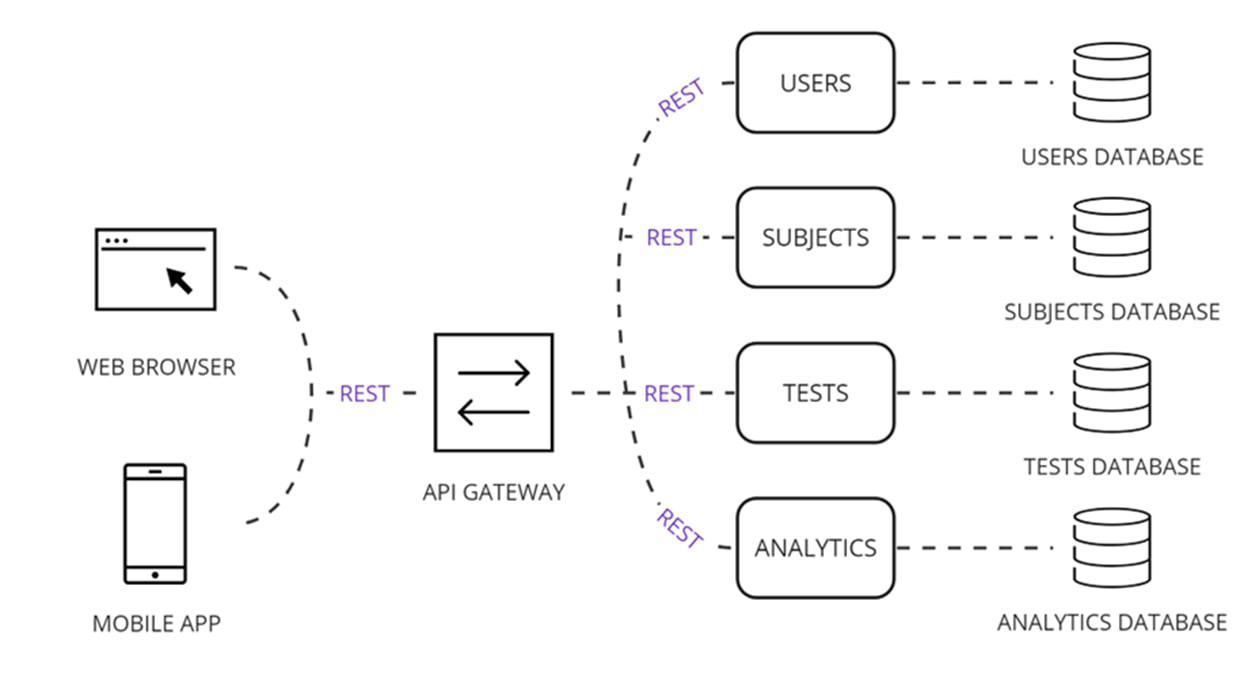
Figure 1 - Service architecture for Intelligent cross-testing
Module "Subjects" – Stores information about subjects and topics on which tests can be created and solved.
Module "Tests" – Stores information about tests, including authors, test questions with answer options, details about correct answers, test moderation, and status.
Module "Intelligent Analytics" – Stores information about users, their achievements analyzed based on compiled and completed tests, and received awards. This information is utilized to analyze user behavior and assess their knowledge and skills.
Additionally, a separate service, an AI-based intelligent bot, participates in testing on par with learners, yet remains "invisible" to them. This service ensures that test results obtained by the same person across different communities are taken into account. For instance, creative abilities necessary for a manager, health indicators influencing professional activity, and other qualities are effectively assessed through test results spanning various subjects or skills. Trained via interactions with diverse learner and teacher groups, the bot offers an objective comparison of learner performance in different subjects, groups, schools, etc. As the bot is employed across various groups and programs, it accumulates and aggregates training samples for self-learning. Consequently, the bot specializes and enhances its capabilities over time, evolving into an indispensable assistant for educators and organizers across different community compositions and even varying topics.
Functional interfaces of the MVP Quiz-platform are depicted in Figures 2, 3, and 4
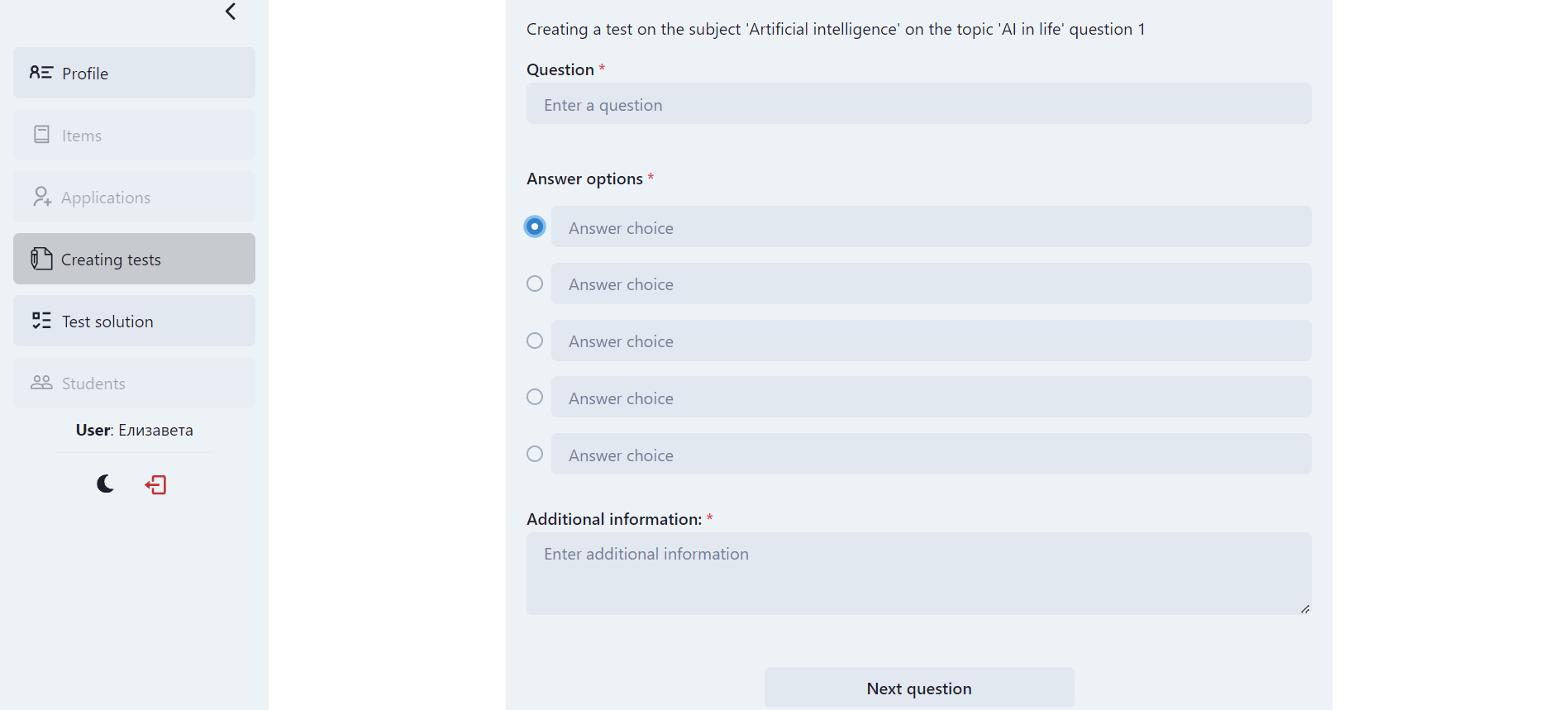
Figure 2 - Creating a test
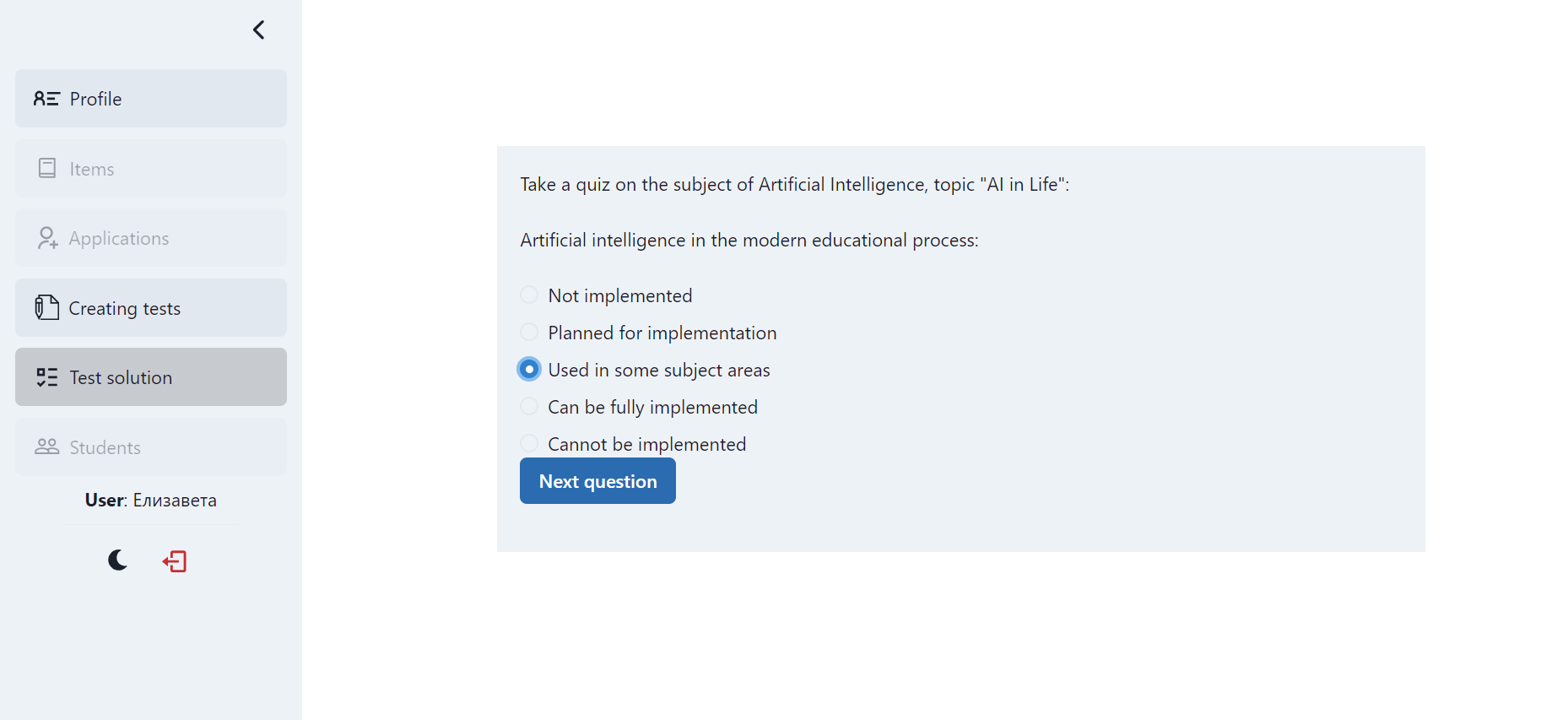
Figure 3 - Test solution
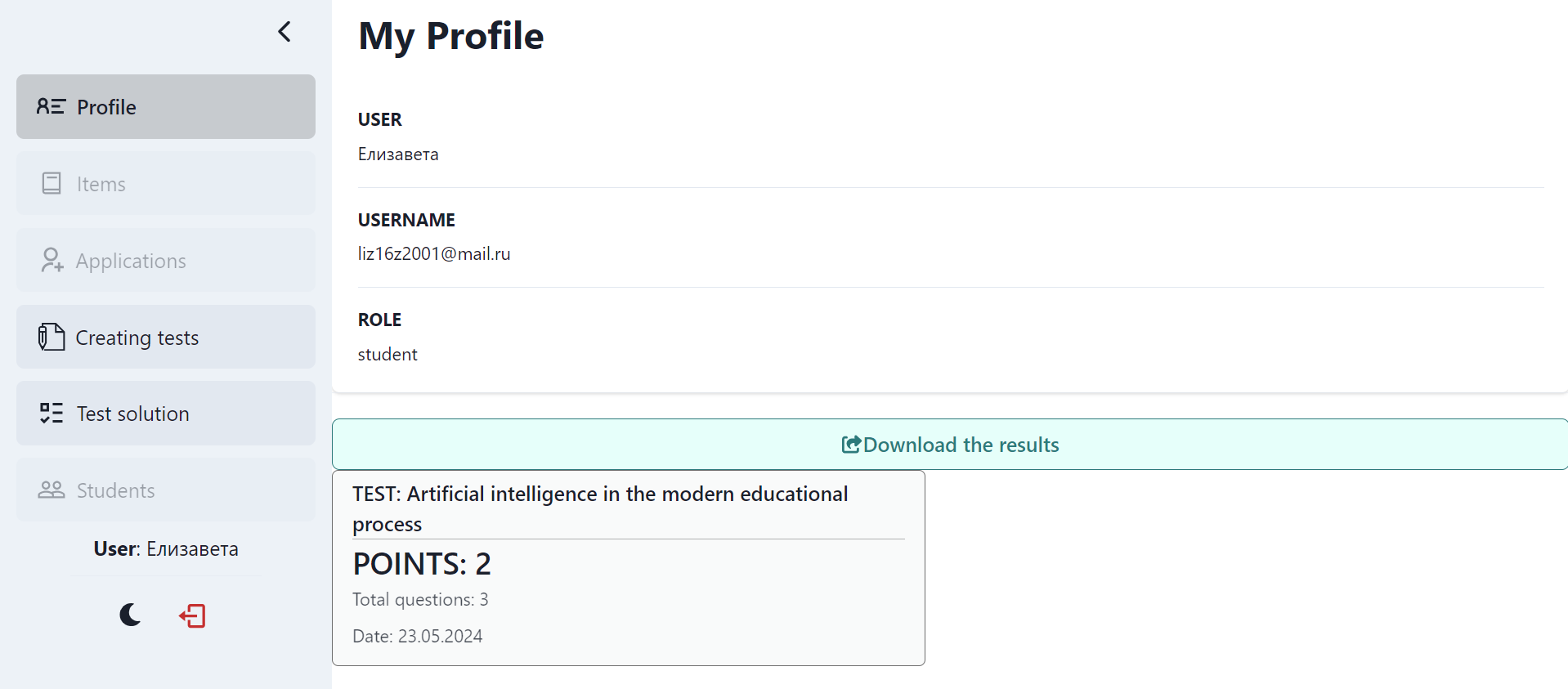
Figure 4 - Results
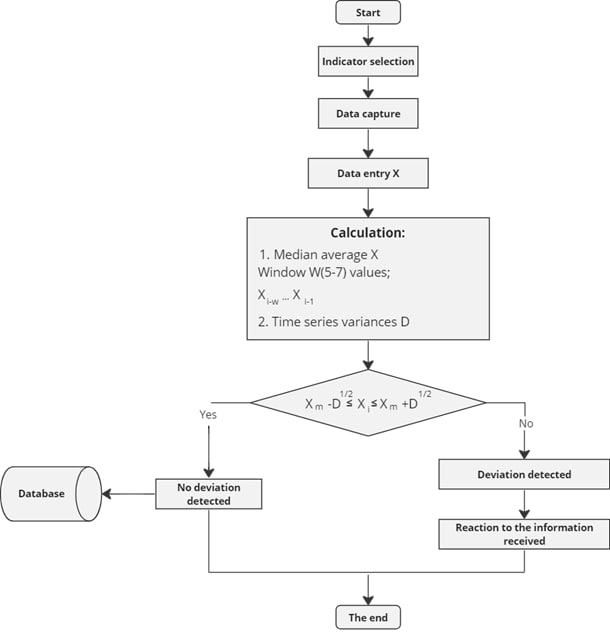
Figure 5 - General monitoring algorithm
5. Conclusion
1. Technology for forming Personal Digital Image (PDI) and decision-making algorithms based on cross-testing have been developed for educational, professional, and everyday contexts. Cross-testing facilitates the evaluation of diverse intellectual and psychophysical performance through mutual assessment among participants.
2. To assess psychophysical performance, subjects are regularly tested in sync with their biological rhythms (sleep, eating, work duties, etc.), using minimally intrusive and often engaging methods (e.g., game-based motivation).
3. The processed data results are leveraged to evaluate the impact of factors like fatigue, illness, disorder, etc., on potential risks in task performance and the full realization of individual capabilities. Additionally, they can aid in predicting diseases at early stages within preventive medicine systems.
